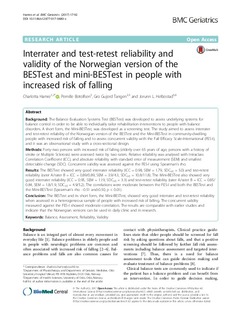| dc.contributor.author | Hamre, Charlotta | |
| dc.contributor.author | Botolfsen, Pernille | |
| dc.contributor.author | Tangen, Gro Gujord | |
| dc.contributor.author | Helbostad, Jorunn L. | |
| dc.date.accessioned | 2018-01-04T10:31:09Z | |
| dc.date.available | 2018-01-04T10:31:09Z | |
| dc.date.created | 2017-04-24T13:55:43Z | |
| dc.date.issued | 2017 | |
| dc.identifier.citation | BMC Geriatrics. 2017, 17 (92), 1-8. | nb_NO |
| dc.identifier.issn | 1471-2318 | |
| dc.identifier.uri | http://hdl.handle.net/11250/2475566 | |
| dc.description.abstract | Background
The Balance Evaluation Systems Test (BESTest) was developed to assess underlying systems for balance control in order to be able to individually tailor rehabilitation interventions to people with balance disorders. A short form, the Mini-BESTest, was developed as a screening test. The study aimed to assess interrater and test-retest reliability of the Norwegian version of the BESTest and the Mini-BESTest in community-dwelling people with increased risk of falling and to assess concurrent validity with the Fall Efficacy Scale-International (FES-I), and it was an observational study with a cross-sectional design.
Methods
Forty-two persons with increased risk of falling (elderly over 65 years of age, persons with a history of stroke or Multiple Sclerosis) were assessed twice by two raters. Relative reliability was analysed with Intraclass Correlation Coefficient (ICC), and absolute reliability with standard error of measurement (SEM) and smallest detectable change (SDC). Concurrent validity was assessed against the FES-I using Spearman’s rho.
Results
The BESTest showed very good interrater reliability (ICC = 0.98, SEM = 1.79, SDC95 = 5.0) and test-retest reliability (rater A/rater B = ICC = 0.89/0.89, SEM = 3.9/4.3, SDC95 = 10.8/11.8). The Mini-BESTest also showed very good interrater reliability (ICC = 0.95, SEM = 1.19, SDC95 = 3.3) and test-retest reliability (rater A/rater B = ICC = 0.85/0.84, SEM = 1.8/1.9, SDC95 = 4.9/5.2). The correlations were moderate between the FES-I and both the BESTest and the Mini-BESTest (Spearman’s rho −0.51 and-0.50, p < 0.01).
Conclusion
The BESTest and its short form, the Mini-BESTest, showed very good interrater and test-retest reliability when assessed in a heterogeneous sample of people with increased risk of falling. The concurrent validity measured against the FES-I showed moderate correlation. The results are comparable with earlier studies and indicate that the Norwegian versions can be used in daily clinic and in research. | nb_NO |
| dc.language.iso | eng | nb_NO |
| dc.publisher | BioMed Central | nb_NO |
| dc.rights | Navngivelse 4.0 Internasjonal | * |
| dc.rights.uri | http://creativecommons.org/licenses/by/4.0/deed.no | * |
| dc.title | Interrater and test-retest reliability and validity of the Norwegian version of the BESTest and mini-BESTest in people with increased risk of falling | nb_NO |
| dc.type | Journal article | nb_NO |
| dc.type | Peer reviewed | nb_NO |
| dc.description.version | publishedVersion | nb_NO |
| dc.source.pagenumber | 1-8 | nb_NO |
| dc.source.volume | 17 | nb_NO |
| dc.source.journal | BMC Geriatrics | nb_NO |
| dc.source.issue | 92 | nb_NO |
| dc.identifier.doi | 10.1186/s12877-017-0480-x | |
| dc.identifier.cristin | 1466234 | |
| dc.description.localcode | © The Author(s). 2017 Open Access This article is distributed under the terms of the Creative Commons Attribution 4.0 International License (http://creativecommons.org/licenses/by/4.0/), which permits unrestricted use, distribution, and reproduction in any medium, provided you give appropriate credit to the original author(s) and the source, provide a link to the Creative Commons license, and indicate if changes were made | nb_NO |
| cristin.unitcode | 194,65,30,0 | |
| cristin.unitname | Institutt for nevromedisin og bevegelsesvitenskap | |
| cristin.ispublished | true | |
| cristin.fulltext | original | |
| cristin.qualitycode | 1 | |

